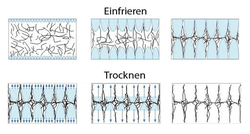You are here: Home / Cryo Competence Center Life Science / Biomaterial Biomaterial
3D carrier materials with tailor-made structure and composition
No matter wether in regenerative medicine or in vitro in the lab – for the development of tissue-like structures and for fulfillment of their physiological functions, somatic cells need suitable structures. For the 3-dimensional cell cultures the substrate materials made of synthetic or natural polymers need to fit perfectly in their chemical composition and their 3-dimensional structure to the requirements of the cultivated cell types. We have developed biodegradable carrier materials from collagen and gelatin for the use in regenerative medicine and tissue-typical cell culture.
Tailor made Cell culture scaffolds und composites
With the patented freeze-drying process „model-based ice templating (MBIT)“ we have created a technique for tailor-made manufacturing of high porous 3-dimensional collagen scaffolds. With this method we are able to produce 3-dimensional collagen scaffolds of any size. Structure, pore size and macro- and micro porosity can be created according to your wishes and become attuned perfectly to cell type and intended purpose. For the co-culture of different cell types or the guided tissue regeneration (GBR/GTR) it is possible to freeze out a barrier of compacted material to subdivide the scaffolds in two separate areas. Through the addition of tissue typical polysaccharides and minerals it is possible to generate composite materials with perfect properties for the organotypic culture of mucosa, dermal- or bone tissue.
Perfect cell culture stability and remodeling properties
Collagen and gelatin degrade in moist environments quickly. In the cell culture these endogenous polymers are additionally modified and degraded by cellular proteins. To use these natural biopolymers as carriers for cells, a stabilization against hydrolytic and enzymatic degradation is necessary.
For applications in regenerative medicine, the cell-seeded biological matrix is transplanted to the body. There the carrier structure is resorbed in the course of tissue regeneration. The rate of the matrix degeneration needs to match the regeneration rate. Through a targeted crosslinking of our 3-dimensional scaffolds with suited chemical and physical methods, we customize the cell culture stability and the degradation rate exactly to their intended purpose.





